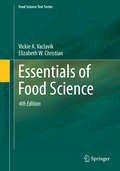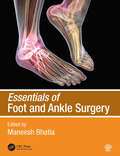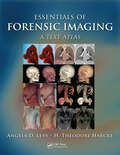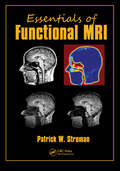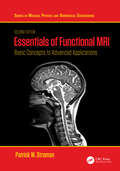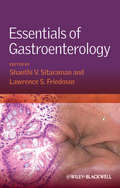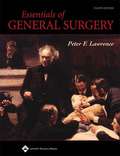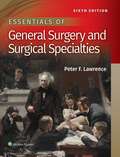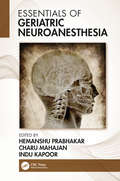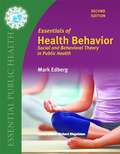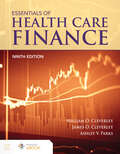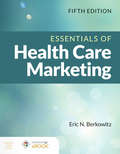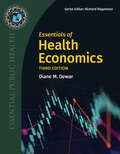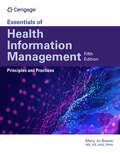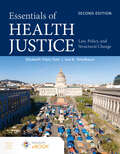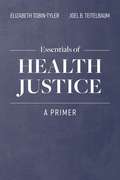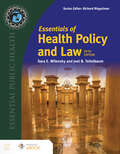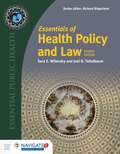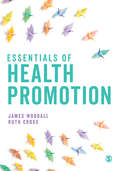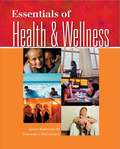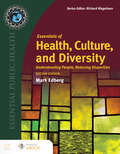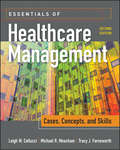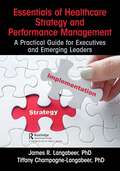- Table View
- List View
Essentials of Food Science
by Vickie A. Vaclavik Elizabeth W. ChristianThe fourth edition of this classic text continues to use a multidisciplinary approach to expose the non-major food science student to the physical and chemical composition of foods. Additionally, food preparation and processing, food safety, food chemistry, and food technology applications are discussed in this single source of information. The book begins with an Introduction to Food Components, Quality and Water. Next, it addresses Carbohydrates in Food, Starches, Pectins and Gums. Grains: Cereals, Flour, Rice and Pasta, and Vegetables and Fruits follow. Proteins in Food, Meat, Poultry, Fish, and Dry Beans; Eggs and Egg Products, Milk and Milk Products as well as Fats and Oil Products, Food Emulsions and Foams are covered. Next, Sugar, Sweeteners, and Confections and a chapter on Baked Products Batters and Dough is presented. A new section entitled Aspects of Food Processing covers information on Food Preservation, Food Additives, and Food Packaging. Food Safety and Government Regulation of the Food Supply and Labeling are also discussed in this text. As appropriate, each chapter discusses the nutritive value and safety issues of the highlighted commodity. The USDA My Plate is utilized throughout the chapters. A Conclusion, Glossary and further References as well as Bibliography are included in each chapter. Appendices at the end of the book include a variety of current topics such as Biotechnology, Functional Foods, Nutraceuticals, Phytochemicals, Medical Foods, USDA Choosemyplate. gov, Food Label Health Claims, Research Chefs Association certification, Human Nutrigenomics and New Product Development.
Essentials of Foot and Ankle Surgery
by Maneesh BhatiaThis book is a ‘go-to’ guide for postgraduate Orthopaedic examinations as well as for Orthopaedic surgeons for trauma and elective foot and ankle surgery. A streamlined approach ensures that the 22 core topics are covered in a succinct and practical way. Foot and ankle surgery is a vast topic that can be daunting to revise due to the complex and diverse nature of associated pathologies. This highly illustrated succinct text, together with key learning points ensures a rapid understanding of all the essential elements of foot and ankle surgery. * Provides ‘need -to-know’ information for Orthopaedic surgeons * Assists with exam preparation for postgraduate exit exams such as the FRCS (Trauma & Orth) * Simple, succinct and concise * Over 500 illustrations to aid learning * Accompanying website with MCQs and videos of clinical examination and surgical techniques Orthopaedic surgeons, registrars and trainees, other specialty doctors, general practioners and physiotherapists with musculoskeletal interest and podiatrists will all find here ‘gold standard’ answers to foot and ankle conditions.
Essentials of Forensic Imaging: A Text-Atlas
by Angela D. Levy H. Theodore Harcke Jr.Bringing the long tradition of radiologic pathologic correlation to forensic radiology and autopsy, this volume provides readers with a technical and interpretive foundation for applying modern cross-sectional imaging to forensic autopsy. The book integrates more than 300 color images with basic forensic pathology in a topical format. The rich pictorial display of case material that accompanies the text establishes a contextual understanding of the material. Following an introduction to basic concepts and a review of imaging techniques, chapters are organized by cause of death. The atlas-like presentation is supported by full text explanations that review relevant forensic and radiologic principles.
Essentials of Functional MRI (Series in Medical Physics and Biomedical Engineering)
by Patrick W. StromanDuring the last two decades, new developments in functional MRI (magnetic resonance imaging) have made it possible to detect changes in the brain over time, as opposed to the "snapshot" produced by conventional MRI. Essentials of Functional MRI breaks down the technical challenges for physicians, researchers, and technologists who use functional MR
Essentials of Functional MRI: Basic Concepts to Advanced Applications (Series in Medical Physics and Biomedical Engineering)
by Patrick W. StromanEssentials of Functional MRI is explained from the basic theory underlying magnetic resonance imaging. This includes how it can be used to detect dynamic variations in neural activity to become “functional” MRI, and how fMRI can be used for a variety of applications. The reader will gain an understanding of how fMRI is currently used, its limitations, and how it is still developing. This is achieved by explaining the core concepts and building on them to explain how fMRI data are acquired and what physiological information they provide. These ideas are the key to understanding how the data are analyzed to detect physiological changes that are related to neural activity. With an understanding of the basic underlying concepts, the way that fMRI is used, and its limitations, are much easier to understand. This 2nd edition includes explanations of new advances in MRI techniques and fMRI data analysis methods, and updated examples of applications of fMRI, including current or future clinical applications. This book is intended for students, researchers, and clinicians, who want to understand the theory and practice of fMRI in sufficient detail to use it for neuroscience research, clinical research, and for clinical practice.
Essentials of Gastroenterology
by Shanthi Sitaraman Lawrence S. FriedmanHighly practical and concise, this hands-on guide focuses on specific common clinical scenarios. Each section covers a particular area of the GI tract and follows a regular structure of: overview of normal function, physiology, pathophysiology, clinical presentation, differential diagnosis, diagnostic tests, and treatment. Color-coded text features, such as key facts, potential pitfalls and practice tips, and concise, bulleted paragraphs make the information easy to find and assimilate. Multiple choice questions, clinical cases, a short picture gallery of the most common GI conditions, and a comparison of the major societies' guidelines (BSG, ASG, ACG, UEGF) make this the perfect tool for reference or review.
Essentials of General Surgery (Fourth Edition)
by Peter F. Lawrence Richard M. Bell Merril T. Dayton Mohammed I. AhmedEssentials of General Surgery, Fourth Edition is extensively revised with an abundance of new tables and illustrations, to provide the most current and up-to-date information on general surgery. The book covers the most need-to-know information about specific diseases and areas of surgery and meets all the guidelines of the Association of Surgical Educators. Additional features include an atlas of images, multiple-choice questions, and case studies.
Essentials of General Surgery and Surgical Specialties: Textbook And The Essentials Of Surgical Specialties
by Peter F. LawrencePublisher's Note: Products purchased from 3rd Party sellers are not guaranteed by the Publisher for quality, authenticity, or access to any online entitlements included with the product. Now combining general surgery and the specialties in one volume, this Sixth Edition of Essentials of General Surgery and Surgical Specialties focuses on the information all medical students need to know to pass the NBME surgery shelf or other surgery rotation examinations. This new edition of Lawrence’s popular text offers concise, high-yield content and a smaller format ideal for study on the go. Updated to reflect the latest advances in the field, it provides the authoritative, up-to-date content today’s busy medical students need for exam success.
Essentials of Geriatric Neuroanesthesia
by Hemanshu Prabhakar Charu Mahajan Indu KapoorThe book covers topics ranging from basic sciences (developmental changes in neuroanatomy and neurophysiology and effects of neuropharmacology) to special situations such as brain death, ethical issues and palliative care. It discusses various neurological surgical problems and their challenges along with common problems such as Alzheimer’s and Parkinson’s disease. A section on Pain covers all possible modalities for relieving pain in this patient population followed by the important issue of palliative care. The book addresses the issue of cognition decline, common in this group. The fact that basic sciences are included along with clinical sciences makes it a unique read for the audience.
Essentials of Global Mental Health
by Samuel O. OkpakuMental illness accounts directly for 14% of the global burden of disease and significantly more indirectly, and recent reports recognise the need to expand and improve mental health delivery on a global basis, especially in low and middle income countries. This text defines an approach to mental healthcare focused on the provision of evidence-based, cost-effective treatments, founded on the principles of sharing the best information about common problems and achieving international equity in coverage, options and outcomes. The coverage spans a diverse range of topics and defines five priority areas for the field. These embrace the domains of global advocacy, systems of development, research progress, capacity building, and monitoring. The book concludes by defining the steps to achieving equality of care globally. This is essential reading for policy makers, administrators, economists and mental health care professionals, and those from the allied professions of sociology, anthropology, international politics and foreign policy.
Essentials of Health Behavior (Second Edition)
by Mark EdbergHealth promotion, education, and prevention programs ultimately focus on changing health behavior. Essentials of Health Behavior, Second Edition provides the groundwork for understanding, assessing, and effectively applying theories of human behavior within the practice of public health. In clear and accessible language, it provides the student with a background of the kinds of social and behavioral theories that guide our understanding of health related behavior and form the background for health promotion and prevention efforts. Filled with real life examples and profiles, the text explores some of the ways in which these theories and approaches are used in applied health promotion efforts. This book will:- Introduce students to the relationship between behavior and a selection of major health issues. - Provide an introductory background to the kinds of social and behavioral theories that guide our understanding of health related behavior and form the background for health promotion and prevention efforts. - Explore some of the ways in which these theories and approaches are used in applied health promotion efforts. The Second Edition offers:- New chapter on multi-level theories and frameworks - Updated examples of application and practice throughout- Additional information on several of the theories presented, such as the Diffusion of Innovations theory and the Social Cognitive TheoryLooking for more real-life evidence? Check out Cases 3, 5-11, 13, 18, & 20 in Essential Case Studies in Public Health, Putting Public Health into Practice.
Essentials of Health Care Finance
by William O. Cleverley James O. Cleverley Ashley V. ParksBlending the topics of both accounting and finance, Essentials of Health Care Finance is a relevant, readable, and easily applied resource for health care management students and executives that explores finance theory and its practical application in health care across a full range of facilities, from hospitals, home health agencies, and skilled nursing facilities to surgical centers, physician practices, and integrated health systems. Carefully revised, the Ninth Edition of Essentials of Health Care Finance has been updated with additional reflection, examples, and application so that individuals with no healthcare experience can benefit from additional elaboration on key concepts such as physician practice management, flex budgeting, and strategic financial planning. The Ninth Edition also explores trends in national health expenditures and physician organizations and alignment; changes in health services financing and utilization since the enactment of the Affordable Care Act (ACA)
Essentials of Health Care Marketing, Fifth Edition
by Eric N. BerkowitzEssentials of Health Care Marketing, Fifth Edition provides students with a foundational knowledge of the principles of marketing and their particular application in health care. Offering an engaging and accessible approach, the Fifth Edition of this highly current text offers new content on social media and digital marketing, a thorough consideration of ethics, and additional multimedia to add relevance and further engage students. New to the Fifth Edition: New chapter on social media and digital marketing to fully explore marketing for the modern college student who is constantly engaged by social media. New chapter on ethics that covers areas of topical interest and debate in health care marketing. Coverage of the most current, cutting-edge developments in the field including: invigorating discussions in marketing theory, the new concept of “Customer Empowerment,” wholly revised discussion of pricing in relation to trends in value-based payment, new pricing and payment models,
Essentials of Health Economics, Third Edition
by Diane M. DewarWritten with the non-specialist in mind, Essentials of Health Economics, Third Edition examines the public health care system through the lens of economic theory. Through numerous examples, case studies, and profiles related to the field, students will learn the importance of health economics and its relevance to more general analysis of health policy issues.With new information on healthcare reforms faced at the state, national, and international level, new chapter on COVID,19, fresh profiles of notable economists, updated statistics, and more, the Third Edition provides a timely and accessible introduction that focuses on how to do descriptive, explanatory, and evaluative economics in a systematic way. Learn more about Third Edition in this video interview with Diane Dewar. New chapter on COVID-19 that provides a case study in emergency preparednessExpanded chapters on technology and health care workforce discuss the roles of digital health and physician extenders, respectivelyNational and international comparisons provided throughout given the global nature of health and healthcareNewly updated chapters in health care reform in national, state, and international realmsUpdated statistics and current events in policy and economics throughout End-of-chapter real world case studies encourage for application of principles discussed in each chapterUpdated and/or new notable economist profiles for students to learn about the field of health economics Health Economics courses in programs of public health, health administration, nursing, pharmacy and other allied health professions. © 2026 | 200 pages
Essentials of Health Information Management: Principles and Practices
by Mary Jo BowieESSENTIALS OF HEALTH INFORMATION MANAGEMENT: PRINCIPLES AND PRACTICES, Fifth Edition, provides a comprehensive introduction to fundamental Health Information Management concepts applicable to a wide variety of allied health professions. Learning objectives are correlated and mapped to current CAHIIM curriculum standards, and each chapter includes key terms, assessments and case studies to reinforce student comprehension. Updated and expanded to reflect key industry trends, legal and regulatory developments and advances in technology, the Fifth Edition features new content on information systems, data management and security, ethics and cultural diversity and cultural competence, as well as timely resources related to telehealth and telemedicine. In addition, the product suite includes a variety of print and digital options for both instructors and students.
Essentials of Health Justice: Law, Policy, and Structural Change
by Joel B. Teitelbaum Elizabeth Tobin-TylerBuilding and expanding upon the prior edition of Essentials of Health Justice, the new second edition of this unparalleled text explores the historical, structural, and legal underpinnings of racial, ethnic, gender-based, and ableist inequities in health, and provides a framework for students to consider how and why health inequity is tied to the ways that laws are structured and enforced. Additionally, it offers analysis of potential solutions and posits how law may be used as a tool to remedy health injustice. Written for a wide, interdisciplinary audience of students and scholars in public health, medicine, and law, as well as other health professions, this accessible text discusses both the systems and policies that influence health and explores opportunities to advocate for legal and policy change by public health practitioners and policymakers, physicians, health care professionals, lawyers, and lay people.
Essentials of Health Justice: A Primer
by Joel B. Teitelbaum Elizabeth Tobin-TylerThis book examines the social and structural determinants of health, systems of care for underserved populations, health equity, social justice and health policy. Unlike other texts of its kind, this book uniquely focuses on the legal, structural, and justice issues underlying health disparities; the adequacy of current safety net programs and legal protections affecting the health of vulnerable populations; health policy, law and system design focused on achieving health equity; and concrete strategies for bringing about change to promote health justice. This book can serve as a stand-alone text or supplement for a range of undergraduate, graduate, law, public health, medical, nursing and other health professions courses.
Essentials of Health Policy and Law
by Joel B. Teitelbaum Sara E. WilenskyEssentials of Health Policy and Law, Fifth Edition provides students of public health, medicine, nursing, public policy, and health administration with an introduction to a broad range of seminal issues in U.S. health policy and law, analytic frameworks for studying these complex issues, and an understanding of the ways in which health policies and laws are formulated, implemented, and applied. Thoroughly revised, the Fifth Edition explores the key health policy and legal changes brought about by the Biden Administration and the presently Democrat-controlled Congress. It also addresses the Covid-19 pandemic, and its many devastating and intertwined health, economic, and social consequences. New chapters provide an overview of Public Health and explain Public Health Emergency Preparedness.Updated figures, tables, statistics, and discussion questionsNew textbox icons identify discussion questions, special topics and, technical spotlights to help faculty pick and choose the appropriate contentNew or updated content in the areas of national and state health reform, the healthcare delivery and public health systems, the policymaking process, the ACA's effect on Medicaid, Medicare, and CHIP, individual rights in health care, structural and social drivers of health, and more.New concluding chapter on Health Advocacy teaches readers the art and skill of advocacy.Fully updated Interactive timeline incorporated into the eBook Undergraduate and graduate courses in Health Policy in Public Health, Health Administration, Nursing, Medicine, and Public Policy. © 2023 | 350 pages
Essentials of Health Policy and Law
by Joel Teitelbaum Sara WilenskyPublic opinion polls, media coverage, legal disputes, and policy debates at all levels of government and in private industry attest to the important place that individual health care and public health and safety hold in the minds of the American public, policymakers, and lawmakers. Essentials of Health Policy and Law, Fourth Edition provides students of public health, medicine, nursing, public policy, and health administration with an introduction to a broad range of seminal issues in U.S. health policy and law, analytic frameworks for studying these complex issues, and an understanding of the ways in which health policies and laws are formulated, implemented, and applied. Concise and straightforward, this text is particularly known for its focus on national health reform under the Affordable Care Act (ACA). Additionally, the Fourth Edition offers: <P><P>- A unique chapter on the social determinants of health and the role of law in improving health. - New content related to health reform; the healthcare system; the ACA's effect on Medicaid, Medicare, and CHIP; and incentivizing healthcare quality and private payer reform efforts. - A significantly revised chapter on Public Health Preparedness Policy, reflecting an increased focus on natural disasters, controlling infectious diseases, and military emergencies. - A how-to chapter on writing a policy analysis offers readers step-by-step instructions and examples for writing a policy brief. - Valuable instructor's resources, including PowerPoint slides, test questions for each chapter, blog post updates, and more.
Essentials of Health Promotion
by James Woodall Ruth CrossA complete one-stop-shop for any student of health promotion. How to improve and protect public health is one of the biggest questions facing the 21st century and this book exists to help tackle it head on. Setting out the What, Why, When, Who, Where and How of health promotion across 20 bite-sized chapters. It explores the full range of theories, context and strategies that influence contemporary health promotion. Key features: Comprehensive coverage: all facets of health promotion introduced and explained Combines the theoretical with the practical: knowledge blended with the key skills and attributes needed for effective health promotion Extensive range of global case studies: read about the enormous range of possibilities and creative ways health promotion can be achieved This is the ideal textbook for any undergraduate or pre-registration student starting their health promotion or public health journey. It provides a complete package of information that will lay the groundwork for your learning and future practice and will help you succeed with assignments, essays and exams.
Essentials of Health Promotion
by James Woodall Ruth CrossA complete one-stop-shop for any student of health promotion. How to improve and protect public health is one of the biggest questions facing the 21st century and this book exists to help tackle it head on. Setting out the What, Why, When, Who, Where and How of health promotion across 20 bite-sized chapters. It explores the full range of theories, context and strategies that influence contemporary health promotion. Key features: Comprehensive coverage: all facets of health promotion introduced and explained Combines the theoretical with the practical: knowledge blended with the key skills and attributes needed for effective health promotion Extensive range of global case studies: read about the enormous range of possibilities and creative ways health promotion can be achieved This is the ideal textbook for any undergraduate or pre-registration student starting their health promotion or public health journey. It provides a complete package of information that will lay the groundwork for your learning and future practice and will help you succeed with assignments, essays and exams.
Essentials of Health and Wellness
by Deborah J. Mccormick James Robinson IIIEach of the 13 million high school students in public high schools are required to take one semester of health education. For health instruction to be successful, the instructional program should be grounded in good science, include a behavioral component, and be packaged in a way that can be easily implemented. Essentials of Health and Wellness provides the teacher with everything needed to engage the learner and to create a successful health course. It is designed to be student friendly and is centered on the important, but often overlooked, notion of building personal wellness. All health concepts are brought back to the student, who is encouraged to develop positive wellness behaviors through the creation of a personal wellness plan. Based on the framework of the National Standards for School Health Education, this product is the total package for high school health education. With a small but rich ancillary offering, including a separate Sexuality Supplement (ISBN 1-4018-1525-1)that goes into greater detail about sensitive issues that may not be desirable to all school districts and a free Online Companion with additional lesson plans, teaching activities, and student worksheets, this text provides teachers with a well-rounded, effective system for health education instruction.
Essentials of Health, Culture, and Diversity: .
by Mark EdbergWith diversity, including cultural diversity, increasingly become the norm, it has become even more essential for students and those planning to work in public health to have more than a cursory understanding of the important cultural dimension of the human societies and groups with whom they'll be partners. Essentials of Health, Culture, and Diversity: Understanding People, Reducing Disparities, Second Edition examines what is meant by culture and the ways which culture intersects with health issues, and explores how public health efforts can benefit by understanding and working with cultural processes. Using a range of conceptual tools and research methods, this text provides an overview of specific domains where culture and health intersect, including: varying definitions of health/well-being; understandings of health risk; illness causation and treatment theories (ethnomedical systems); healing/curing traditions; the relationship between health risk (vulnerability) and socio-cultural structures; gender and health; and the meaning of 'cultural competency.' A brief review of a range of cases and examples that span several health issues where health problems, as well as health interventions, were impacted by cultural factors.An overview of research methods that focus on obtaining "cultural data."A focus on four current public health issues where culture and health intersect: HIV/AIDS, obesity, youth violence, and the COVID-19 epidemic.An exploration of the ways in which an awareness of the culture-health relationship can inform public health work, both domestic and international.Real-life examples and profiles as well as suggested exercises and activities help readers in understanding concepts and their applicationTwo in-depth case studies on autism spectrum disorder and indigenous historical trauma illustrate the broad scope interactions between culture and healthNavigate eBook Access (included with the printed text) for convenient online or offline access to the digital text from your computer, tablet, or mobile device. Culture and Health Multicultural Health Cutural Diversity and Health Practices Transcultural Patterns of Health and Culture Or similar courses in departments of Public Health, Health Science, Health Education, Nursing/Community Nursing/Public Health Nursing, Allied Health Professions, Medicine, Anthropology, and Sociology © 2023 | 250 pages
Essentials of Healthcare Management: Cases, Concepts, and Skills, Second Edition (Gateway to Healthcare Management)
by Leigh CellucciInstructor Resources: This book's Instructor Resources include a test bank, presentation PowerPoint slides, answer guides to the in-book Mini Case Study questions, teaching guides for the part-opener case studies, and a transition guide to the new edition. Healthcare managers are tasked with ensuring an organization’s mission is carried out, its goals are achieved, and its work is of high quality. Essentials of Healthcare Management: Cases, Concepts, and Skills provides a solid foundation for developing the skills managers need to help move their organization forward. This introductory book is for those preparing for entry- or midlevel healthcare management jobs. Aligned with the competency categorization developed by the Healthcare Leadership Alliance, it provides a knowledge base and develops aptitude in interpersonal skills such as leadership, professionalism, communication, and teamwork, as well as in business skills such as finance, human resources management, strategy, and marketing. The book is rich with compelling case studies depicting true events and situations. Every chapter opens with a case study to promote experiential learning and to anchor the chapter’s subsequent coverage of theories and concepts. Examples include “Resisting Change,” “Strange Behavior,” “The Ethics Committee,” and “A Longer Than Necessary Hospitalization.” Wrapping up every chapter, mini-case studies such as “MedMan and Its Cultural Climate,” “What Do We Do About Joe?,” and “Developing the Budget for the Dialysis Center” give students the opportunity to apply the theories and concepts covered. Each major part of the book is introduced with a longer case study that instructors can use to highlight the significance of the material addressed in the part’s chapters. End-of-chapter questions and exercises are equally well suited for in-class discussion or team assignments. Originally published as Essential Techniques for Healthcare Managers, this book has been extensively revised. All chapters have been significantly rewritten and updated. Particularly notable are enhancements to the coverage of strategy and marketing, operations, quality, and health information technology. The following chapters are entirely new and provide context and background for the subsequent chapters that address interpersonal and business skills:A Brief History of the Development of Healthcare in AmericaHealth Policy: Cost, Quality, and AccessThe Healthcare System TodayMedical and Healthcare EnvironmentsBlending theory and practical applications, Essentials of Healthcare Management equips future leaders with the skills, knowledge, and confidence they need to be successful healthcare managers.
Essentials of Healthcare Strategy and Performance Management: A Practical Guide for Executives and Emerging Leaders
by James R. Langabeer Tiffany Champagne-LangabeerLeaders and healthcare organizations, and students aspiring to become one, should be asking themselves one thing in these financially challenging times: how can they maintain a strategic and competitive advantage over other players in their market? Some healthcare organizations have faced extremely poor financial performance in recent years, with data suggesting that up to 10% of hospitals will go bankrupt or face closure within the next 10 years. Yet, little pragmatic evidence exists to offer insights into how to create better strategies to improve performance, build resiliency and align stakeholders.Essentials of Healthcare Strategy and Performance Management explores the most critical components of business strategy and performance management for modern, complex healthcare organizations. Using pragmatic and real-world evidence, this book provides essential briefings on key topics that every current or aspiring leader needs to know in order to better manage strategy and achieve improved performance in their hospital or health system. We will also specifically focus on implementation of strategy, and best practices for some of the most important quality management techniques. We hope this book helps inspire leaders to be creative in formulating more effective competitive strategy.
